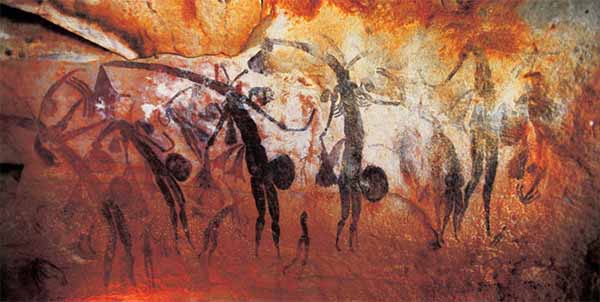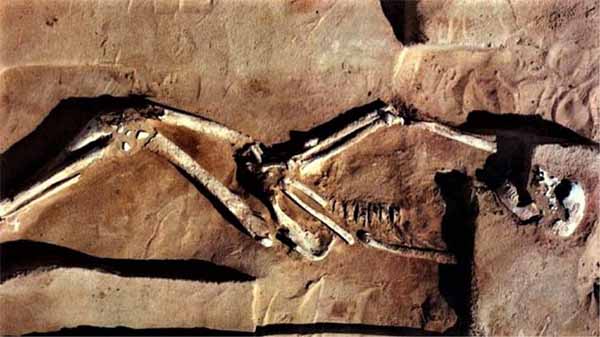Who Were The First Australians ?

Even by Australian standards, the Kimberley region is isolated. It is located deep in western Australia, separated from the islands of the Indonesian archipelago by the deep trench of the Timor Sea. The landscape here is rough and rugged and the climate, like most of the rest of the country, is hot and dry except during the wet season when torrential rains make the area inaccessible. The Kimberley is home to Australia’s three most dangerous animals in abundance: spiders, snakes and crocodiles. Despite the inhospitable nature of this region, it is believed to have been one of the first inhabited regions of the continent and, as such, the archaeological research carried out has the potential to shed light on one of the most controversial issues in the study of the first humans: when and how was Australia first colonized and who were these first Australians ?
Bradshaw rock paintings

Evidence of a primitive human settlement in the Kimberley comes in the form of rock paintings dubbed with the rather incongruous art name Bradshaw, after the settler who first described them in the 19th century. It is notoriously difficult to date petroglyphs, a term used in scientific circles to refer to rock paintings. Where possible, the Bradshaw paintings have been estimated to be several thousand years old, which has led some to date the arrival of the aborigines who today live in the area. Such claims have sparked controversy, which has been used by those seeking to undermine the land rights of Indigenous peoples both in the Kimberley and in other parts of Australia.
The Bradshaw Art Study illustrated the difficulties faced by those trying to investigate the colonization of Australia. These studies quickly become minefields of prejudice and political conformity. Perhaps this is the reason why in Australia very little is said about the abundance of rock paintings - tens of thousands of examples have been found scattered over an area the size of Spain - and that these primitive works of art are almost completely unknown outside the country. But that didn't stop everyone. Individuals of a more determined nature, who braved the criticism and insults that inevitably entailed, have greatly expanded our knowledge of when and how the first humans arrived in Australia.
Mungo man

The fossilized skeleton of the first known Australian was discovered in 1974, near Lake Mungo in southern New South Wales. The dating of the Mungo man, as he was baptized, was widely controversial. Ultimately, it was said to be between 40,000 and 60,000 years old, with the continent's earliest colonization at the time estimated to be 30,000 years ago. This dating is still not accepted by everyone, but a certain consensus exists as to how the first Aborigines arrived. With no other possibility than a huge voyage across the ocean, it is generally believed that men crossed the Timor Sea in boats and rafts. Back then, the expedition would have been much easier than the 480 km sea crossing today. Until the end of the last Ice Age, around 10,000 years ago, sea levels were much lower resulting in the creation of the Sahul landmass, comprising Australia, New Guinea and Tasmania. These lands were still separated from the Sunda continental shelf in Southeast Asia by the trench in the Timor Sea, but the distance was then only 100 km. As temperatures rose and glaciers melted, sea levels rose and the traces left by these early inhabitants were covered. If archaeological objects still exist, they are located 90 m underwater.
Surface physical evidence is therefore unlikely to be found, but there are other ways to investigate the matter. A study published in 2011 and conducted by researchers at the University of Copenhagen, details the first sequencing of the aboriginal genome, using DNA isolated from a sample of hair collected 100 years ago from an aboriginal of Western Australia. Genome analysis showed that the first Australians separated from other human beings around 70,000 years ago and arrived in Australia 20,000 years later. This largely corroborates the dating of Mungo Man and suggests that when these men arrived, they spread across the continent relatively quickly. The genome also indicates that the Aborigines living in Australia today are descended directly from the early settlers, making them one of the oldest societies to have permanently occupied the same territory in the world outside of Africa.
The aboriginal genome
The diversity of languages spoken across Aboriginal Australia is another indication of the age of these societies. Over 250 language groups have been identified, with many dialects existing within each group, suggesting that indigenous peoples have been present on the continent for thousands of years due to the length of time required for that many languages to develop. Further indications of the age of Aboriginal societies can be found in some traditional tales, which recount legends of mythical ancestors who are said to have created both the Aboriginal people and the places where they live. This is the subject of the central theme of Aboriginal culture, called the “Dreamtime”, a mythical era associated with no specific historical period. According to these stories, from the moment that men have existed, they have always lived in the same place. The differences between these mythological accounts of creation and the results obtained by research in the fields of archeology, genetics and linguistics, are quite obvious, but at the same time, a parallel can be drawn between them because they come to the same conclusion: the Aborigines have lived on the Australian continent for a very long time.
In recent years, advances in science have improved our knowledge of the presence of early humans in Australia, to the extent that it is now possible to say, with a reasonable degree of certainty, that those who live on the continent today are the descendants of the first inhabitants who colonized the continent about 50,000 years ago. The Kimberley's Bradshaw rock paintings could relate to the period of this first settlement, which would mean that they are among the earliest examples of rock art in the world, making them just as important as Neolithic cave paintings in Western Europe. If so, then, rather than wanting to undermine the rights of the Aborigines, as some have suggested, they can provide further confirmation, with the support of science, of their claims to have always lived on their land.









































































































































































































































































































































